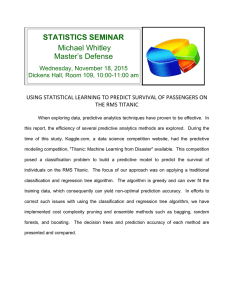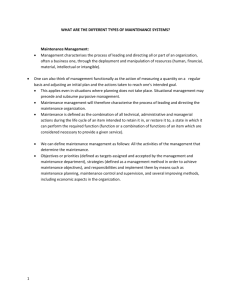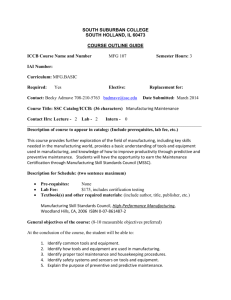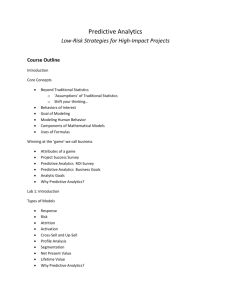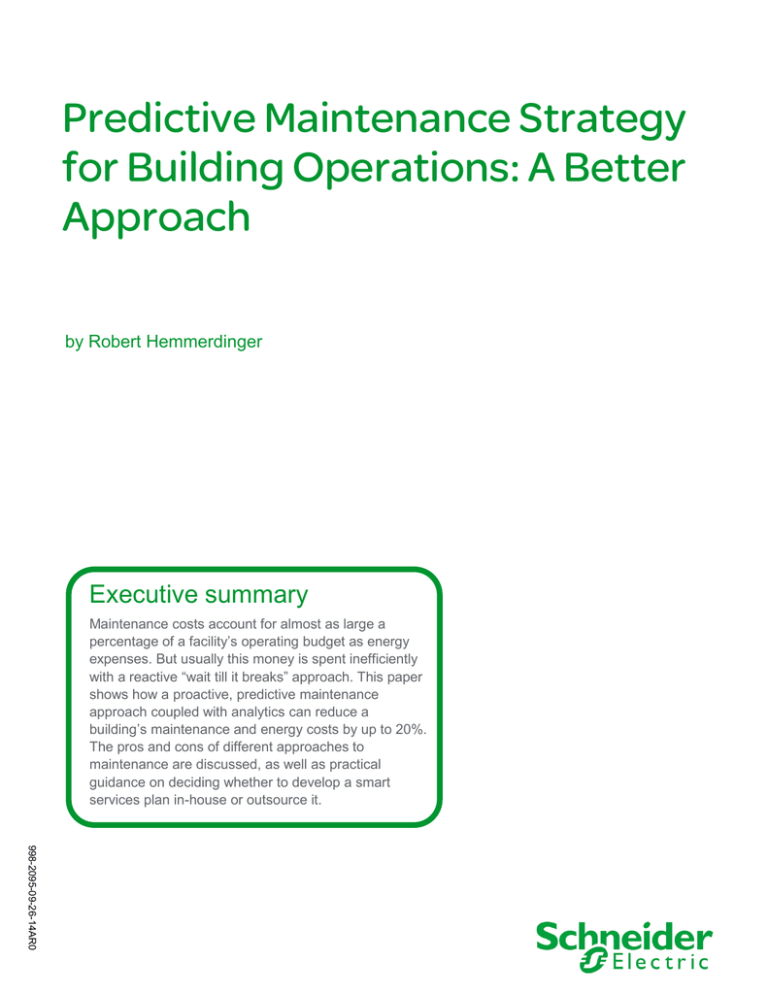
Predictive Maintenance Strategy
for Building Operations: A Better
Approach
by Robert Hemmerdinger
Executive summary
Maintenance costs account for almost as large a
percentage of a facility’s operating budget as energy
expenses. But usually this money is spent inefficiently
with a reactive “wait till it breaks” approach. This paper
shows how a proactive, predictive maintenance
approach coupled with analytics can reduce a
building’s maintenance and energy costs by up to 20%.
The pros and cons of different approaches to
maintenance are discussed, as well as practical
guidance on deciding whether to develop a smart
services plan in-house or outsource it.
998-2095-09-26-14AR0
Predictive Maintenance Strategy for Building Operations: A Better Approach
Introduction
Building owners invest significant resources in environmental and building control systems.
These systems can be costly to operate, yet essential for occupant comfort, productivity, and
safety. Keeping systems operating at peak performance also reduces energy use and lowers
utility costs, a growing concern for building owners worldwide.
Maintenance constitutes a significant percentage of expenses in most facilities, and is
therefore worth optimizing. As shown in Figure 1, maintenance costs consume nearly as
much of a typical facility’s operating budget as utility costs and amount to more than one-third
of the total operating expenses.
Figure 1
Maintenance expenses are
almost as big a part of a
building’s budget as energy
costs.
Source: IFMA, October 2009
The question is, where and why is this money spent — and can the amount be reduced while
maintaining or improving building performance? To answer this question, first one needs to
understand the different approaches used to manage facility maintenance.
Figure 2
A typical facility’s
maintenance costs per
square foot are almost as
expensive as energy costs.
Source: IFMA, October 2009
Schneider Electric White Paper
Revision 0
Page 2
Predictive Maintenance Strategy for Building Operations: A Better Approach
Despite the importance and expense of maintaining building efficiency, most building
1
owners/operators — some 55% in the United States — rely on reactive maintenance
2
programs to care for their equipment. (See Figure 3.) This means they wait until equipment
falters or fails completely before initiating corrective action. In fact, referring to reactive
maintenance as “maintenance” is a misnomer; it should really just be called “repair.” By
waiting until actual failure, these building operators ensure that repair costs will be at a
maximum and that there will be interruptions in service while the repairs are made.
Figure 3
Most facilities take a reactive
approach to maintenance —
the least cost-effective
method.
Source: US Department of Energy, August 2010
“Referring to reactive
maintenance as
‘maintenance’ is a
misnomer; it should really
just be called ‘repair.’”
Slightly less than a third of building operators take a preventive maintenance approach,
which means performing regular, prescheduled maintenance checks and repairs — whether
they are needed or not. This approach yields better results but is still not optimal.
A more efficient way to incur minimal costs and achieve maximum availability is to implement
service plans that use proactive and predictive maintenance based on the actual condition
of equipment rather than a predetermined schedule. With this approach, equipment is
maintained at a continuously high level of performance rather than waiting for something to
fail. In addition, a predictive approach can be used to prioritize repairs and maintenance so
that the most important systems (as judged by the building owner/operator) are repaired first,
ensuring the most effective return on investment (ROI).
While reactive maintenance is the most popular approach, and predictive maintenance the
3
least so, among top-performing facilities the opposite is true (see Figure 4). The highestperforming facilities overwhelmingly use preventive maintenance and rarely utilize reactive
maintenance.
1
“Operations & Maintenance Best Practices: A Guide to Achieving Operational Efficiency,” Federal Energy
Management Program, U.S. Department of Energy, August 2010
2
3
Worldwide percentages are similar.
Operations & Maintenance Best Practices: A Guide to Achieving Operational Efficiency,” Federal Energy
Management Program, U.S. Department of Energy, August 2010
Schneider Electric White Paper
Revision 0
Page 3
Predictive Maintenance Strategy for Building Operations: A Better Approach
Figure 4
Most top-performing facilities
take a predictive approach to
maintenance — the most
cost-effective method
“Proactive, predictive
maintenance and
analytics can save up to
20% per year on
maintenance and energy
costs.”
The most efficient approach is to include advanced analytics to leverage the big data
generated by today’s modern building management systems (BMS). This data provides
accurate, timely, and actionable information that can be leveraged to refine service programs
even further and achieve optimal building performance and cost-effectiveness. Building
owners/operators can make data-driven decisions based on the impact that the
recommended maintenance will have on the efficiency of buildings’ performance.
4
According to U.S. government figures, such a comprehensive operations and maintenance
program for energy and water systems, based on proactive, predictive maintenance and
analytics, can save up to 20% per year on maintenance and energy costs, while increasing
the projected lifetime of the building by several years. The predictive maintenance approach
is gaining ground among facility owners and operators, as experience with this type of
approach grows and the cost-justification increasingly becomes understood.
This paper compares the pros and cons of the various approaches to maintenance, with a
particular emphasis on using analytics software to leverage BMS data. It then discusses
some of the issues that building owners/operators should consider when choosing a vendor
to provide the components of a “smart service” plan that the building owners/operators cannot
or do not choose to provide themselves.
A note on terminology: The terms used in this paper to describe the three maintenance
approaches — reactive, preventive, and predictive — are generally recognized and accepted
by facility professionals. Some professionals use the term proactive, but that is not precise
enough for the purposes of this paper, since that term can cover both preventive and
predictive maintenance.
Reactive
maintenance:
pros and cons
Reactive maintenance is the practice of fixing equipment when it breaks down or when
performance deteriorates to a point that is no longer acceptable. This is the traditional
approach to maintenance, because it is the most natural — we tend to fix things when they
break. That’s also why it is the most commonly used — it’s how things have always been
done, and offers the path of least resistance.
Advantages The apparent advantages of this approach are twofold. In the short term, it can
seem to cost less. For example, in a given week, the cost of maintenance equals only what it
takes to repair a broken unit. If nothing breaks, then very little has been spent on
maintenance. However, as discussed below, these savings are an illusion. The second
4
“Operations & Maintenance Best Practices: A Guide to Achieving Operational Efficiency,” Federal Energy
Management Program, U.S. Department of Energy, August 2010
Schneider Electric White Paper
Revision 0
Page 4
Predictive Maintenance Strategy for Building Operations: A Better Approach
advantage is that it requires minimal staff. Most facilities practicing reactive maintenance
employ the minimum staff required to “get by,” and equipment is fixed as the staff can
manage it.
This approach might work well when all equipment is new, since a high degree of uptime and
sound performance are reasonable expectations early in the equipment’s lifecycle.
Disadvantages The disadvantages of reactive maintenance are numerous but mostly not
visible to management, which is why so many facilities continue to use this approach.
Frequently cited disadvantages include:
• Increased cost due to unplanned downtime of equipment
• Increased labor costs, especially if overtime is needed
• Cost involved with repair or replacement of equipment
• Possible secondary equipment or process damage from equipment failure
• Inefficient use of staff resources — who are always in “firefighting mode”
In most cases, these disadvantages are simply the opposite of the advantages. For example,
consider the cost of unplanned equipment downtime. Any savings achieved by not doing
repairs on the boiler in one week are more than wiped out if the heating breaks down the
following week in the middle of winter. Productivity could grind to a halt if it’s too cold to open
the offices. Business is forced to wait for the maintenance staff to make the needed repairs.
“The apparent cost
savings of reactive
maintenance are an
illusion.”
This can lead to the second point, increased labor costs. Business necessity may require that
outside help be called in or that the staff be paid overtime to work extra hours. And if the
business chooses not to pay that expense, it must wait until the building is habitable again.
Either way, this scenario adds substantially to maintenance costs.
Although reactive maintenance can work with new equipment, there is a caveat. In the same
way a new car needs regular oil changes, new equipment needs monitoring and adjusting,
and possibly early-intervention maintenance. Failure to provide such maintenance will
eventually lead to the same fate as the automobile that did not receive proper care from day
one — just as the car’s engine will seize up, building systems will fail prematurely and the
lifetime cost of equipment will skyrocket.
Simply, it is cheaper to change the oil regularly than to replace the engine. This maxim is the
guiding principle behind the next most commonly used maintenance approach, preventive
maintenance.
Preventive
maintenance:
pros and cons
Preventive maintenance refers to the regular maintenance of equipment according to a
predetermined schedule that is based on equipment characteristics and capabilities, usually
provided by the equipment manufacturer. To continue the car analogy, this approach can be
likened to regularly changing the oil every 5,000 miles, along with other regular service
milestones such as 30,000- and 50,000-mile checkups.
A preventive maintenance program typically would include regularly scheduled activities such
as changing belts and filters, cleaning indoor and outdoor coils, lubricating motors and
bearings, cleaning and maintaining cooling towers, testing control functions and calibration,
and painting for corrosion control.
Advantages As would be expected, preventive maintenance does a better job of
maintaining uptime and good equipment performance than the reactive approach. For this
Schneider Electric White Paper
Revision 0
Page 5
Predictive Maintenance Strategy for Building Operations: A Better Approach
reason, it also is less expensive over any significant length of time, because there are fewer
emergencies and less unplanned downtime.
“With preventive
maintenance, facilities
personnel are not
necessarily working on
the most important things
first.”
Studies indicate that facilities can save from 12% to 18% using preventive maintenance
5
techniques, versus reactive maintenance.
Disadvantages A drawback of preventive maintenance is the lack of prioritization. In other
words, all equipment is treated equally and maintenance is performed by “going down the list”
of recommended actions. There is no system for ranking maintenance activities according to
potential consequences of equipment failure, so facilities personnel are not necessarily
working on the most important things first. For example changing a filter on an air handler
would carry the same weight as replacing a temperature sensor in a chilled water system. But
the former has minimal impact on building performance, whereas failure of the latter can be
catastrophic, especially to facilities with data centers.
The “checklist” approach of preventive maintenance is better than “wait till it breaks” reactive
maintenance, but is less efficient and effective than the optimal approach, predictive
maintenance.
Predictive
maintenance:
pros and cons
Like preventive maintenance, predictive maintenance is based on the tenet that a proactive
approach is better than a reactive one. However, instead of making repairs based on a
predetermined calendar schedule, the predictive approach makes repairs based on the actual
condition of the equipment.
For example, in a predictive maintenance program, key operating parameters of equipment
are checked regularly by staff or monitored automatically by sensors. The readings are then
analyzed and used to evaluate the condition of the equipment and predict the future
performance or likelihood of failure.
The key to predictive maintenance is that equipment and system condition determines what
maintenance is performed, rather than a preset schedule. This means that repairs are
performed at the ideal time, resources are not wasted on unnecessary work, and equipment
is maintained at a higher level of performance.
“Predictive maintenance
makes repairs based on
the actual condition of the
equipment.”
Advantages Predictive maintenance can save another 8% to 12% overall, versus
preventive programs. Surveys show that in some specific areas, the savings can be even
greater: 6
• 10X return on investment
• 25–35% deduction in maintenance costs
• 70–75% fewer breakdowns
• 35–45% reduction in downtime
• 20–25% increase in production
Predictive maintenance activities can be prioritized in-house if staff levels allow. A significant
investment in additional personnel and training may be needed. A facility would need a
sufficient number of staff that have the technical expertise to continuously monitor and trend
all of the data coming out of the BMS and compare that information against optimal
performance benchmarks supplied by each manufacturer. Then the maintenance needs to be
5
“Operations & Maintenance Best Practices: A Guide to Achieving Operational Efficiency,” Federal Energy
Management Program, U.S. Department of Energy, August 2010
“Operations & Maintenance Best Practices: A Guide to Achieving Operational Efficiency,” Federal Energy
Management Program, U.S. Department of Energy, August 2010
6
Schneider Electric White Paper
Revision 0
Page 6
Predictive Maintenance Strategy for Building Operations: A Better Approach
prioritized based on potential cost and comfort impact. It is important to note that most likely
additional staff would then be required to actually go out and fix the issues found.
It has been shown that predictive maintenance can extend the lifetime of a building by
several years. Other benefits include increased safety from properly maintained equipment,
greater comfort and productivity for occupants, and better compliance with efficiency
requirements.
Figure 5
Although carrying a
higher start-up cost,
predictive maintenance
is more cost-effective in
the long run.
Source: US Department of Energy, August 2010
“The biggest hurdle will be
changing the
organizational culture to
look at maintenance in a
new way.”
Analytics:
pros and cons
Disadvantages One perceived disadvantage of predictive maintenance is cost.
Organizations may need to earmark funds to implement and support new software platforms
capable of capturing data on the actual condition of systems and equipment. Facilities staff
may need further training, and perhaps additional staff would need to be hired. These factors
obviously require a larger budget than the assumed “no problems” budget of reactive
maintenance (i.e., where the planned expense is essentially $0). Whether in-house or
outsourced, incorporating analysis and prioritization drives the costs significantly higher. All of
these factors will depend heavily on the size and culture of the company that is managing the
facility, but the startup cost is not negligible. However, as with the perceived savings in
reactive maintenance, this supposed higher expense is an illusion (see Figure 5). The return
on investment for predictive maintenance is realized several times over. Nevertheless, this
higher initial cost presents a challenge for some organizations, since a predictive
maintenance program requires buy-in and approval from upper management. The biggest
hurdle will be changing the organizational culture to look at maintenance in a new way.
As mentioned above, predictive maintenance can utilize automated sensors and expert
knowledge to help prioritize maintenance. Taking this concept a step further, it is possible to
integrate all of the data coming from the BMS and combine it with advanced analytics
capabilities to create a “smart service plan.” The plan provides accurate information about
facility issues and then ranks them by how they impact the business in different areas such
as energy cost, comfort, and maintenance urgency.
Since most buildings today are “smart” to some degree — meaning they have some type of
BMS capability — implementing a “smart” service plan is a natural next step. Such a plan
allows the facility to leverage the data that the BMS collects and put it to use in new ways to
reduce energy use and overall costs.
Schneider Electric White Paper
Revision 0
Page 7
Predictive Maintenance Strategy for Building Operations: A Better Approach
As a report by IDC Energy Insights states, “End users have heightened visibility into how their
equipment is operating when analytics and data management solutions become integrated
with building systems. These tools allow the building operator to monitor set points and
7
schedules and establish rules for alarms.”
“Adoption of analytics for
facility maintenance is
expected to grow by 20%
annually worldwide over
the next few years.”
Advantages The expected ROI of a smart service plan can be calculated directly from the
facility’s data, so its implementation can be justified to upper management. Other benefits
include:
• Streamlining operations and maintenance
• Facility differentiation — smart, green buildings are a competitive advantage
• Achieving corporate goals
Case Study
Facility: A 5-year-old, 450,000square-foot research laboratory
serving a mix of lab, office, and
educational space.
Smart Solution: Building
analytics diagnostics and
reporting identified several
major problems, including
leaking and malfunctioning
cooling coil valves in three air
handlers and leaking heating
coil valves in almost 200 VAV
boxes.
Results: Based on the
recommendations provided, the
operations team was able to
schedule repairs by prioritizing
the most wasteful leaks first.
Repairs resulting in $165,000
(€120,000) in annual savings
have already been completed
with additional repair work
ongoing.
For enterprises that operate multiple facilities, a smart service plan promises even greater
return on investment since it enables a broader view of maintenance and equipment
performance, allows comparisons to be made among facilities and teams, and propagates
best practices.
An additional advantage is the tight integration of maintenance with all other facility
operations, giving building owners/operators a single view of their operations. By eliminating
the silos of information about a facility, and showing how they all interact on a daily basis,
facility managers can make better decisions that take into account all the parameters of
building performance and all the stakeholders, from owners and operators to tenants and
employees.
Because of these advantages, the adoption of analytics for facility maintenance is expected
8
to grow by 20% annually worldwide over the next few years.
Disadvantages The data analysis capabilities to support a smart service plan are not easy
to build internally. First, a facility needs a robust BMS solution in place, capable of gathering
large amounts of diverse data on all aspects of building and equipment performance. Second,
the kind of analysis software required is not standard in BMS solutions, and in fact requires
special expertise by professionals who are skilled in its use.
Some enterprises may wish to invest in developing their own staff to implement a smart
service plan, while others may choose to engage a third-party service provider.
Do-it-yourself
or outsource?
Some very large companies and government facilities might have the resources to completely
manage their own service and maintenance plans. In fact, for enterprises with a large staff
and maintenance budgets, predictive maintenance and smart service–type plans will be a
logical way to leverage their considerable resources.
Most facility staffs, however, will find it challenging to find, hire, and train the necessary
people within the constraints of their budget. As noted earlier, a predictive maintenance plan
requires an investment in new staff and training. Some facilities may find it more economical
and flexible to outsource the implementation of such a plan. For facilities wishing to take the
next step to a smart service plan using analytics, it’s even more likely that third-party help will
be needed.
7
“Business strategy: Analytics and data management for Smart Buildings,” IDC Energy Insights, November
2012
“Business strategy: Analytics and data management for Smart Buildings,” IDC Energy Insights, November
2012
8
Schneider Electric White Paper
Revision 0
Page 8
Predictive Maintenance Strategy for Building Operations: A Better Approach
Maintenance
approach
Recommended
process for vendor
selection
• Develop clear objectives
(comfort, efficiency,
equipment uptime, etc.)
• Develop and apply a
screening process specific to
the site and expectations
• Select 2 to 4 potential
contractors and obtain initial
proposals
• Develop major contract
requirements using the
contractors’ initial proposals
• Obtain final bids from
potential contractors based
on the owner-developed
requirements
• Select the contractor and
develop the final contract
language and service plan
• Manage and oversee the
contracts and documentation
• Periodically review the entire
contract; build in a feedback
process
Source: U.S. Department of Energy
Cons
Reactive
• minimal staff
• lowest initial investment
• least efficient & cost-effective
• increased cost of unplanned
downtime, labor, repair
• inefficient use of staff
Preventive
• more efficient & cost-effective:
12–18% savings over reactive
• less equipment failure/
more uptime
• lack of prioritization
• unnecessary maintenance
Predictive
• highly efficient & cost-effective:
8–12% savings over preventive
• least equipment failure/
most uptime
• improved safety, comfort,
productivity, efficiency
compliance
• greater prioritization
Predictive +
analytics
• most efficient & cost-effective
• greatest prioritization
• streamlined operations
• quantifiable ROI to show
management
Table 1
A summary table
comparing the different
approaches to
maintenance
Pros
• highest initial investment
(staff, training, diagnostics)
• savings potential not
immediately seen by
management
• requires robust BMS
• special expertise
Depending on the scope of operations, most facilities will find it less costly to hire a thirdparty vendor who already has the expertise on-board and can leverage best-practice
experience from many engagements.
A third-party provider of maintenance services should act as an extension of the company’s
own staff, working closely with the facilities department to provide the needed personnel and
expertise, planning guidance, and so on.
What to look for in selecting a vendor depends on an organization’s specific goals, size,
budgets, etc. Some considerations to keep in mind:
• Previous experience Does the provider have experience with this type of facility?
Education campuses, government buildings, life science facilities, industry — all these
building types present their own special challenges.
• BMS and analytics capabilities Even if a building owner/operator doesn’t need these
capabilities now and only wants a manually implemented maintenance plan today, it
may be worthwhile to choose a vendor who offers a broad range of technology and
expertise in case they are wanted in the future.
• Coverage area Does the provider cover the territories for all facilities? A company with
many facilities will find it more effective and economical to deal with one large
maintenance contract provider, rather than many smaller ones. Therefore, a global
company will probably want to find a global maintenance partner.
• Contract flexibility Every enterprise and facility is different and requires its own
maintenance contract. The contract should offer options for length, commitment,
responsibilities, etc., and these options should meet budget limitations and business
goals.
The process used to select a vendor can be an important factor to a successful relationship.
The U.S. federal government has published recommended steps to take when choosing an
outside provider for maintenance and operations services (see sidebar, “Recommended
process for vendor selection”).
Schneider Electric White Paper
Revision 0
Page 9
Predictive Maintenance Strategy for Building Operations: A Better Approach
By instituting a formal “smart service plan” that takes a predictive maintenance approach,
using either internal resources or a third-party provider, building owners/operators can
substantially improve equipment performance, reduce energy costs, and operate a greener
facility. Savings can be increased further by using analytics to leverage the data that is
generated from building management systems.
Most facilities should consider retaining an outside vendor to operate their smart service plan.
Before contacting vendors, facility owners need to educate themselves about a few things.
First they need to take stock of their facility’s technical infrastructure. Understanding the
capabilities of their facility and any internal maintenance resources is a critical first step. The
next step is to contact reputable service providers who can act as a trusted advisor. It is
important to find a service provider that offers a portfolio of service plans to avoid being shoehorned into a one-size-fits-all plan. Good resources include vendor websites,
recommendations from other facility managers/owners, and trade publications. Be sure to
look online for relevant information, such as case studies and webinars that talk about
predictive and preventive maintenance. Government sites can also be a good source of
information. The U.S. Department of Energy has published an excellent reference,
“Operations & Maintenance Best Practices: A Guide to Achieving Operational Efficiency.” A
helpful site in Europe is BUILD UP, a portal for energy efficiency in buildings. Other regions
have their own relevant websites.
It is important to build a case for upper management. Using the arguments and data
presented in this paper, augmented with goals and requirements unique to the facility,
maintenance and facility managers can prepare a strong business case for predictive
maintenance and, optimally, a smart service plan as well.
By educating themselves, establishing clear goals, and screening vendors carefully, facility
owners and operators will be able to find a service plan solution that meets their needs and
budget.
About the author
Robert Hemmerdinger is director of Buildings Field Services Offer Management for
Schneider Electric. He oversees transition services, helping customers upgrade their building
management system (BMS). Previous positions include director of iBMS for the systems line
of business of Schneider Electric and member of the strategic sales team focused on life
sciences and education solutions.
Schneider Electric White Paper
10
Revision 0
Page
© 2014 Schneider Electric. All rights reserved.
Conclusion

